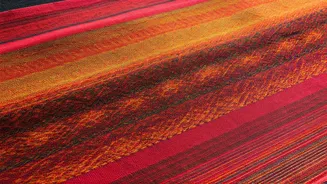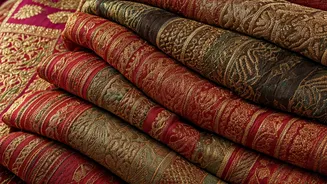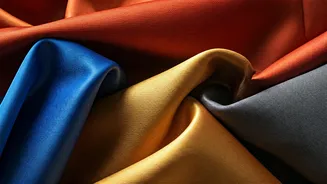Handlooms: A Deep Dive
Handlooms represent a cornerstone of India's fashion history, yet face complex challenges. The article questions what is truly being preserved when handlooms
are discussed, prompting a deeper look at the sector. These traditional textiles are not just about aesthetics; they embody a rich cultural legacy. The evolution of handlooms continues, as designers and artisans strive to balance heritage with contemporary demands. The industry has seen many designers collaborating with weavers to keep the ancient craft alive, while also integrating it into modern designs. However, the future also means adapting to a changing market and ensuring the craft remains relevant in today's fast-paced fashion environment. It needs constant efforts to promote its sustainability and economic viability for weavers.
Fiber Innovations Unveiled
Fashion is continually reinventing itself through pioneering materials. Innovations in fabrics have revolutionized the industry, offering fresh perspectives on design and functionality. From sustainable sources to novel processing techniques, the quest for innovative materials shapes how we perceive fashion. The materials influence not only the look and feel of garments but also their environmental footprint. Designers and researchers now focus on methods that minimize waste and reduce the impact on natural resources. The development of eco-friendly fabrics underscores fashion's increasing commitment to sustainability. Such advances signal a shift towards responsible production, impacting every aspect of the fashion value chain.
Retail Giants in India
India's retail market is attracting the attention of significant global players. This reflects the increasing economic opportunities in the country, attracting major investments. The expansion of these global retail giants has a significant impact on local markets and consumer behavior. As these businesses establish their presence, they also have to align with evolving trends. This includes incorporating Indian elements and catering to the diverse tastes of local consumers. The entry of international brands has encouraged competition in the industry. As the retail landscape evolves, it's essential to analyze the effects on local businesses and the overall trajectory of the Indian fashion market.
Waste to Fashion
The fashion industry is increasingly under pressure to address its environmental impact. This has led to the emergence of innovative initiatives, such as the use of waste materials. Recycling and upcycling are becoming key strategies for many fashion houses and designers. Collaborations between artists and environmental organizations are becoming more common in the fashion world, showcasing creativity. These projects not only transform waste into fashionable items but also highlight the need for sustainability. Initiatives like these help promote greater awareness about waste management and highlight the significance of eco-conscious fashion choices. By turning trash into treasure, the fashion world proves it can lead positive change.
Bridal Saris of Bengal
The bridal sari of Bengal is an integral part of Bengali culture. It represents traditions and personal stories through its design and appearance. The use of handloom and intricate embellishments displays the rich textile heritage. The designs reflect the artistry and craft of Bengali weavers. The choice of colors, patterns, and textiles used in bridal saris varies, reflecting local preferences. These saris are more than mere garments; they're valuable family heirlooms. With fashion continually changing, the bridal sari remains a symbol of culture. The demand for bridal saris shows how fashion can preserve tradition.
The Bindi's Fashion Role
The bindi, a tiny dot, plays an important part in Indian culture and fashion. It carries deep cultural and spiritual significance. The bindi has been a fashion statement, evolving to fit changing tastes. Fashion designers are modernizing this classic element. The bindi's popularity in global fashion shows its widespread appeal. The bindi represents the merging of tradition and style. It continues to be worn by many, from everyday people to celebrities, solidifying its place in the world of fashion.













